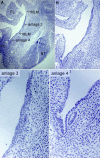Signalling pathways implicated in early mammary gland morphogenesis and breast cancer
- PMID: 16933995
- PMCID: PMC1557774
- DOI: 10.1371/journal.pgen.0020112
Signalling pathways implicated in early mammary gland morphogenesis and breast cancer
Abstract
Specification of mammary epithelial cell fate occurs during embryogenesis as cells aggregate to form the mammary anlage. Within the embryonic mammary bud, a population of epithelial cells exists that will subsequently proliferate to form a ductal tree filling the stromal compartment, and which can produce milk upon terminal differentiation after birth. Subsequently, these structures can be remodelled and returned to a basal state after weaning before regenerating in future pregnancies. The plasticity of the mammary epithelial cell, and its responsiveness to hormone receptors, facilitates this amazing biological feat, but aberrant signalling may also result in unintended consequences in the form of frequent malignancies. Reflecting this intimate connection, a considerable number of signalling pathways have been implicated in both mammary gland morphogenesis and carcinogenesis.
Conflict of interest statement
Competing interests. The authors have declared that no competing interests exist.
Figures




References
-
- Sakakura T. Mammary embryogenesis. In: Neville MC, Daniel CW, editors. The mammary gland: Development, regulation, and function. New York: Plenum Press; 1987. pp. 37–66.
-
- Kratochwil K. Organ specificity in mesenchymal induction demonstrated in the embryonic development of the mammary gland of the mouse. Dev Biol. 1969;20:46–71. - PubMed
-
- Kratochwil K. Tissue combination and organ culture studies in the development of the embryonic mammary gland. Dev Biol (NY 1985) 1986;4:315–333. - PubMed
-
- Propper AY. Wandering epithelial cells in the rabbit embryo milk line. A preliminary scanning electron microscope study. Dev Biol. 1978;67:225–231. - PubMed
-
- Balinsky B . On the developmental processes in mammary glands and other epidermal structures. Trans R Soc Edin. 1949–1950) ;62:1–31.
MeSH terms
Substances
Grants and funding
LinkOut - more resources
Full Text Sources
Other Literature Sources
Medical

